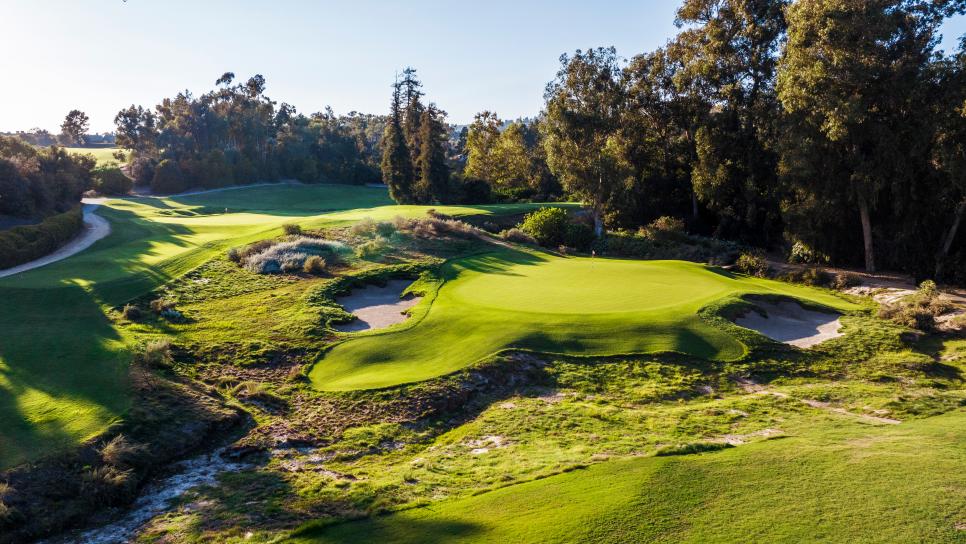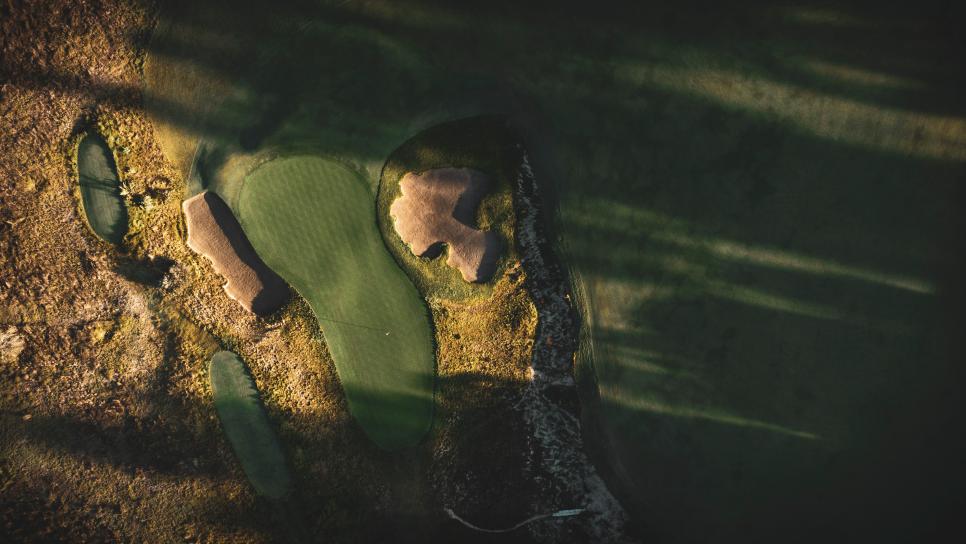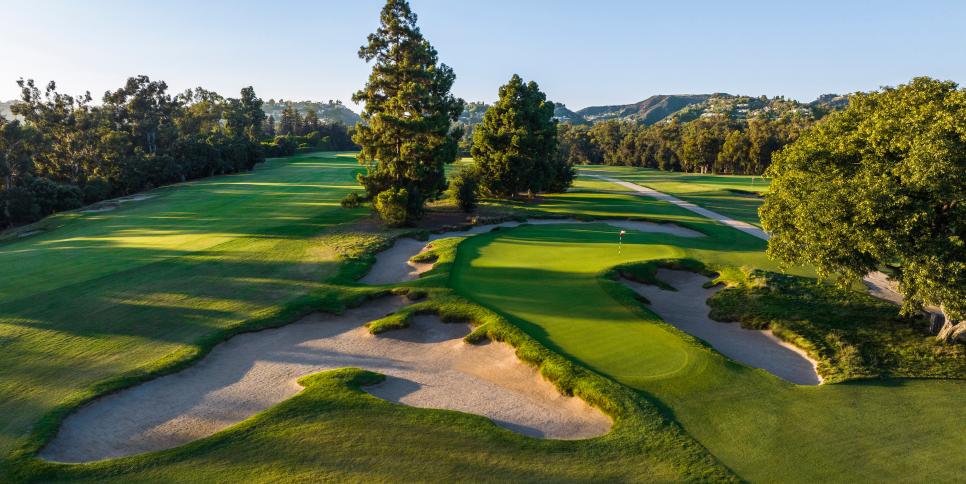showtime
The U.S. Open returns to L.A. after 75 years. It took that long for a reason

THE LAST TIME THE U.S. OPEN TEED OFF IN Los Angeles, Harry Truman was president, Stalin still controlled the Soviet Union, interstate highways didn’t exist and “The Ed Sullivan Show” was 10 days from its debut. Ben Hogan had yet to win an Open, but that would change that week in 1948 with his two-shot victory over Jimmy Demaret at Riviera Country Club, Hogan’s third win at the course in 16 months, including two Los Angeles Opens.
L.A. had worked its magic and found a star. It center-staged arguably the generation’s greatest player and set in motion one of sport’s most mythic comeback stories. Then, remarkably for a city so enamored with sequels, nothing else happened. For reasons to do with the small number of clubs with the status, space and willingness—or availability—to host, the Los Angeles U.S. Open franchise failed to launch.
The Open returns to L.A. this June on the diamond anniversary of Hogan’s win, to the North Course at The Los Angeles Country Club rather than Riviera. It will be like starting over. The North Course will be a novel experience for most of the field except for the few amateurs who competed on it during the 2017 Walker Cup. The design also will introduce elements that are atypical if not baffling for a national championship: fairways that are 40 to 60 yards wide (more in some areas) bordered by just a whiff of Bermuda rough; par 3s that can range from 300 yards to less than 90, with some elastic enough to play three or four clubs longer or shorter from day to day; and the jarring juxtaposition of the property’s rustic, barranca-split setting and the sparkling urban skyline of neighboring Century City.
That Los Angeles Country Club is hosting the U.S. Open at all is another storyline, one that’s out of character for the club. In a city where publicity and promotion are the oxygen it breathes (certainly in this part of town, straddling Wilshire Boulevard in Beverly Hills near the edge of Hollywood), the club is famously spotlight averse. It hasn’t hosted a professional event since the 1940 L.A. Open, and it doesn’t fit neatly into the USGA's well-established mandate for large Open courses with room to support major infrastructure and high spectator traffic. The course is entirely hemmed in by commercial districts and surrounding estates, and getting people in and out will require considerable orchestration (having the adjacent South Course available to absorb necessary overflow makes the event possible).
John Bodenhamer, chief championships officer for the USGA, says Los Angeles Country Club represents the organization’s updated philosophy for considering U.S. Open sites. “Over the years the business model at the USGA had become focused on the need to fit 40,000 people onto the course, and all the economic and market factors had to be there as well. When you consider courses like Merion or even Los Angeles Country Club where that isn’t possible, it ruled certain places out for the USGA,” he says. “We’ve changed that. The model today is based largely on where the players want to contest a U.S. Open. We’ve asked the men and women, ‘Where do you want to win? What places do you want to go?’ It’s interesting to hear what’s important to them, and it has fueled a lot of what we do because it just means more when you go to places that have that gravitas. The ghosts of the past matter.”

A BARRANCA RUNS THROUGH IT There’s no room to miss at the par-3 fourth.
The calendar for the next two decades supports the idea of the Open returning to a group of historically established championship courses with architectural pedigrees. Pinehurst No. 2 has five Opens scheduled, and Oakmont and Pebble Beach each have four. Winged Foot, Shinnecock Hills, Merion and Oakland Hills, with a total of 22 past Opens among them, round out the roster through 2051, and Los Angeles Country Club is on the books again for 2039. “We use the term ‘cathedrals of the game,’ ” Bodenhamer says, “and we think L.A. Country Club is one of those.” The expected attendance, he notes, will be a comparatively modest 22,000 spectators per day.
Architecturally, if not in tournament clout, Bodenhamer is correct. The North Course, 16th on the Golf Digest America’s 100 Greatest Courses ranking, is one of the great triumvirate of courses George Thomas designed in Los Angeles in the 1920s, with Riviera and Bel-Air Country Club, each built with William P. (Billy) Bell. Thomas’ genius was his ability to design strategically complex holes on distinctly different sites. He was a master at incorporating natural terrain and grade changes when available and constructing elaborate bunkers and other architectural apparatuses when not. In the canyons of Bel-Air he routed the holes the only places he could—in the valleys—but used the foothill slopes and shoulders to exciting effect (the financial luxury to link the disparate sections via tunnels and elevators inside mountains plus a suspension bridge over the top certainly helped). At Riviera he could route the holes any way he wanted over a largely featureless plain between two palisades, using a barranca and manufactured features to create the course’s strategic compositions. Los Angeles Country Club falls in between.

FORKING PATHS The drivable par-4 sixth presents a matrix of options.
Thomas was an aspiring golf-course architect when he relocated from Philadelphia to Los Angeles in 1919. He joined Los Angeles Country Club, and shortly afterward assisted British architect Herbert Fowler in upgrading the rudimentary North Course. Thomas’ architectural ideas crystallized as he designed several other Southern California courses and began writing extensively on the topic. When the club asked him to remodel the North Course again in 1927, Thomas eradicated almost everything Fowler had designed by re-routing the holes, locating new green sites and adding the seductively intricate, eroded-edged bunkering he and Bell were known for.
MANY OF THE GREENS WERE DESIGNED TO RECEIVE A RUNNING BALL BANKED OFF FLANKING MOUNDS OR RIDGES.
The North Course plays through three environments. The par-5 first and par-4 18th, the only parts of the Fowler course that remained, roam side by side across the clubhouse plateau. Numbers two through eight drop to a lower section of land and then work their way toward the top of a shallow canyon and back, weaving over and along a broad, dry barranca that can intercept shots on five of the holes. Holes 10 through 16 circle atop an upland that tilts toward the course’s lower sections, and 17 returns to the flats along the barranca. This entire region of northwest Los Angeles, all the way to the Santa Monica Mountains, was treeless agricultural land in the 1920s, and Thomas’ design accentuated the property’s openness, especially the upland holes of the second nine, by constructing broad fairways that could be played along different lines using slopes and high points to maneuver shots depending on how aggressive the player wanted to be. Many of the greens were designed to receive a running ball banked off flanking mounds or ridges.
Thomas’ ideas on lines of play and ground contour culminated in the concept of a “course within a course.” He advanced this idea at Los Angeles Country Club by building numerous tees at staggered distances and orientations to the fairways and greens, a novel concept in 1927. The daily tee setup could be synced to different hole locations on the greens, changing the way the course played and sometimes even changing the par of the hole. The most famous example is the downhill par-3 11th, with tees fanned out along an upper elevation at distances ranging from 100 to nearly 300 yards. From the shorter tees the angle to the green is more diagonal from the right, and depending on where the hole is cut, the choice is to fly the ball onto the green or, for front pins, land it short and allow the fairway downslope to bounce it forward. As the hole lengthens, the tees shift to the left, impacting the angle and the tactics. Possibly playing as a drivable par 4, golfers hitting longer clubs might choose to use the banked Redan-like ground on the left to redirect balls toward back hole locations. Expect the USGA to showcase the versatility.

In 2009, the club brought in architect Gil Hanse and partner Jim Wagner to renovate the North Course. Though it hadn’t been fundamentally altered the way venues like Oakland Hills’ South Course or Oak Hill’s East Course had, much of Thomas’ architecture was dulled. Restoring those faded aspects, including the “course-within-a-course” concept, motivated them. “Genius—the guy was a genius,” Hanse says. “When we were brought in to interview, and I remember this clear as day, we said that we want to put back George Thomas, and if that’s not what you want, then we’re not the right architects to hire.”
Putting Thomas back was a process that required significant tree removal (decades of eucalyptus, sycamore and pine planting had turned LACC into a parkland course with impeded views) to recapture the openness the architecture demands, especially on the upland terrace. The club also roughed up and remediated the barranca, which had become grassed over and lifeless. Billy Bell’s sensuous bunkers with chunky, grassy top edges were reconstructed, as were the greens, though it’s unknown how similar the contours are to what Thomas designed. The late John Harbottle rebuilt them in the 1990s, and Hanse and Wagner, without evidence to the contrary, took it on an act of faith that the previous work was loyal to what had always existed. Those surfaces were laser scanned and reproduced and expanded back out to the edges of the bunkers from which they had receded.

TEMPEST OR TEACUP? The maddening, delightful 15th can play just 85 yards.
The biggest move might have been the replacement of several original greens. Thomas had set the second green on the opposite side of the barranca on a kind of island, but by about 1970 it was shifted to a hillside in the trees, well to the right. The green for the eighth, a split-fairway par 5 playing from the opposite direction, was then extended into the location of the second’s old green site. After considerable discussion, the club agreed to reestablish it, and when the architects began digging, they found remnants of the old green. The same was true of the short par-4 sixth’s green that had been moved back and elevated—that too was rebuilt in its former location. The resurrection of the second green turns the hole into a monstrous 484-yard par 4 where the second shot must carry the barranca. The eighth green was subsequently returned to where Thomas placed it, and the hole skipping left to right and then right to left over the barranca loses nothing for being 65 yards shorter.
“Working at LACC taught us a lot about restoration, but I think more than anything it made Jim and me better architects,” Hanse says. “It enlightened us to the ‘course-within-a-course concept,’ and the angles, strategy and different tees aligned with different hole locations. That was hugely important to us in our design for the Olympic Course in Rio and continues to be something in our new work that we always focus in on and talk about.”
The fairways at LACC will rival the widest in modern U.S. Open history, and the challenge for Bodenhamer and the USGA will be to set up the course in a way that honors Thomas’ architecture—which is exhilarating for members and match play and a range of skill sets—yet still tests the world’s best players in every facet. The key will be to make the turf play firm and fast—not compared to a typical PGA Tour setup but truly firm and fast, something closer to the pre-wall-to-wall irrigation days of Thomas. Bodenhamer understands that importance and expects that balls will be “squirting all over the place,” making controlling distance and calculating runout paramount to success. The Bermuda rough will be cut at less than three inches to start the week and then monitored to find the right height where balls will drop to the roots and not sit up.
“The slope of the ground is the defense for the angles,” Hanse says. “If the balls are running, it will change the angles and the approaches.” The heavily tilted fairways at the third, fifth and 10th holes, for instance, will force players to either walk their drives along the spines and risk being too wide, or carve shots into the slopes to minimize runouts on the low side. The choice should tie back to hole locations that are far more diverse after the green expansions, particularly Thomas’ reestablished “molar” putting surfaces at the third, fifth, 12th and 14th holes. Flags can now be placed in front positions in the roots of the teeth, so to speak, directly over deep bunkers. The players will have to contemplate challenging these forward pins or risk being above the hole, leaving treacherous downhill putts. To be above the hole on any of the greens on the North Course is to be out of position, and being over greens is to be dead.
THE FAIRWAYS WILL RIVAL THE WIDEST IN MODERN U.S. OPEN HISTORY, BORDERED BY A WHIFF OF BERMUDA ROUGH.
Although balance is key, the tee and cupping flexibility give Bodenhamer setup options and opportunities not usually on the table. For instance, the sixth hole, a fascinating downhill par 4 where players can drive the blind green over a hillside or lay back at incremental yardages to align a pitch into the length of a skinny putting surface, might play shorter on some days than the par-3 seventh running along the barranca that can be set up at nearly 300 yards. The teacup 15th, its green shaped like the fat end of the Nike swoosh, can measure 130 yards but is likely to be marked some days at something closer to 85 yards.
Bracketing the 15th are five enormous holes that will sort out the contenders as they come to the finish. Four of them are par 4s that can stretch to well past 500 yards each, and the other is a 633-yard par 5. The North Course can measure nearly 7,600 yards, but the length won’t necessarily favor the longest hitters. “When I think of the North Course and how we might set it up, the player that does his homework and really studies the architecture will benefit,” Bodenhamer says. “We thought that way at The Country Club last year with Matthew Fitzpatrick winning, and he got to know it in 2013 when he won the Amateur there. I think LACC is going to be like that, too, because there are strategic nuances there that, if you understand them, you have an advantage.”
If understanding and repeat viewing matters, look for Collin Morikawa and Scottie Scheffler, who learned the design in-depth during the Walker Cup, to fare well. Patrick Cantlay is familiar with the North Course from his days at UCLA a few blocks away, and Max Homa set the course record of 61 during his days at Cal. After 75 years, the city is once again ready for golf’s premier event, and no matter who wins, Los Angeles Country Club is certain to come out a star.







